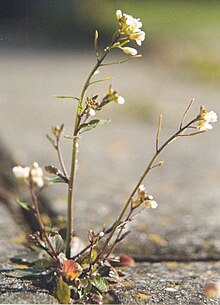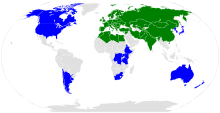Arabidopsis thaliana
| Arabidopsis thaliana | |
|---|---|
 |
|
| Scientific classification | |
| Kingdom: | Plantae |
| (unranked): | Angiosperms |
| (unranked): | Eudicots |
| (unranked): | Rosids |
| Order: | Brassicales |
| Family: | Brassicaceae |
| Genus: | Arabidopsis |
| Species: | A. thaliana |
| Binomial name | |
|
Arabidopsis thaliana (L.) Heynh. |
|
 |
|
The range of Arabidopsis thaliana.
|
|
| Synonyms | |
|
Arabis thaliana |
|
Arabis thaliana
Arabidopsis thaliana (/ərˌæbᵻˈdɒpsɪsˌθɑːliˈɑːnə/ thale cress, mouse-ear cress or arabidopsis) is a small flowering plant native to Eurasia.A. thaliana is considered a weed; it is found by roadsides and in disturbed land.
A winter annual with a relatively short life cycle, A. thaliana is a popular model organism in plant biology and genetics. For a complex multicellular eukaryote, A. thaliana has a relatively small genome of approximately 135 megabase pairs (Mbp). It was the first plant to have its genome sequenced, and is a popular tool for understanding the molecular biology of many plant traits, including flower development and light sensing.
Arabidopsis thaliana is an annual (rarely biennial) plant, usually growing to 20–25 cm tall. The leaves form a rosette at the base of the plant, with a few leaves also on the flowering stem. The basal leaves are green to slightly purplish in color, 1.5–5 cm long and 2–10 mm broad, with an entire to coarsely serrated margin; the stem leaves are smaller and unstalked, usually with an entire margin. Leaves are covered with small, unicellular hairs (called trichomes). The flowers are 3 mm in diameter, arranged in a corymb; their structure is that of the typical Brassicaceae. The fruit is a siliqua 5–20 mm long, containing 20–30 seeds. Roots are simple in structure, with a single primary root that grows vertically downward, later producing smaller lateral roots. These roots form interactions with rhizosphere bacteria such as Bacillus megaterium.
...
Wikipedia
